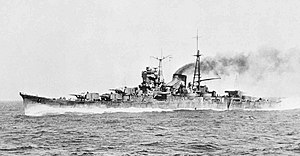Japanese cruiser Mogami (1934)

Mogami running trials in 1935
|
|
| History | |
|---|---|
|
|
|
| Name: | Mogami |
| Namesake: | Mogami River |
| Ordered: | 1931 Fiscal Year |
| Builder: | Kure Naval Arsenal |
| Laid down: | 27 October 1931 |
| Launched: | 14 March 1934 |
| Commissioned: | 28 July 1935 |
| Struck: | 20 December 1944 |
| Fate: | scuttled 25 October 1944 after Battle of the Surigao Strait at 09°40′N 124°50′E / 9.667°N 124.833°ECoordinates: 09°40′N 124°50′E / 9.667°N 124.833°E |
| General characteristics | |
| Class and type: | Mogami-class cruiser |
| Displacement: |
|
| Length: |
|
| Beam: |
|
| Draught: |
|
| Propulsion: |
|
| Speed: |
|
| Range: | 8,000 nmi (15,000 km) at 14 knots (26 km/h) |
| Complement: | 850 |
| Armament: |
|
| Armor: | |
| Aircraft carried: |
|
Mogami (最上?) was the lead ship in the four-vessel Mogami class of heavy cruisers in the Imperial Japanese Navy. She was named after the Mogami River in Tōhoku region of Japan. The Mogami-class ships were constructed as "light cruisers" (per the Washington Naval Treaty) with five triple 6.1-inch dual purpose guns. They were exceptionally large for light cruisers, and the barbettes for the main battery were designed for quick refitting with twin 8-inch guns. In 1937 all four ships were "converted" to heavy cruisers in this fashion.Mogami served in numerous combat engagements in World War II, until she was sunk at the Battle of Leyte Gulf in October 1944.
Built under the Maru-1 Naval Armaments Supplement Programme, the Mogami-class cruisers were designed to the maximum limits allowed by the Washington Naval Treaty, using the latest technology. This resulted in the choice of the dual purpose (DP) 15.5 cm/60 3rd Year Type naval guns as the main battery in five triple turrets capable of 55° elevation. These were the first Japanese cruisers with triple turrets. Secondary armament included eight 12.7 cm/40 Type 89 naval guns in four twin turrets, and 24 Type 93 Long Lance torpedoes in four rotating triple mounts.
...
Wikipedia
